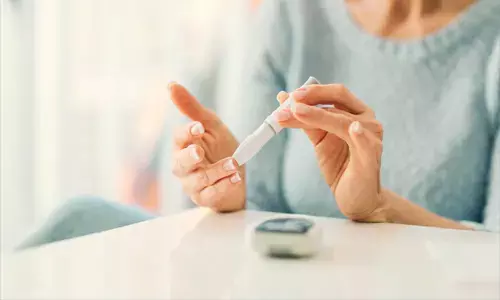- Home
- Medical news & Guidelines
- Anesthesiology
- Cardiology and CTVS
- Critical Care
- Dentistry
- Dermatology
- Diabetes and Endocrinology
- ENT
- Gastroenterology
- Medicine
- Nephrology
- Neurology
- Obstretics-Gynaecology
- Oncology
- Ophthalmology
- Orthopaedics
- Pediatrics-Neonatology
- Psychiatry
- Pulmonology
- Radiology
- Surgery
- Urology
- Laboratory Medicine
- Diet
- Nursing
- Paramedical
- Physiotherapy
- Health news
- Fact Check
- Bone Health Fact Check
- Brain Health Fact Check
- Cancer Related Fact Check
- Child Care Fact Check
- Dental and oral health fact check
- Diabetes and metabolic health fact check
- Diet and Nutrition Fact Check
- Eye and ENT Care Fact Check
- Fitness fact check
- Gut health fact check
- Heart health fact check
- Kidney health fact check
- Medical education fact check
- Men's health fact check
- Respiratory fact check
- Skin and hair care fact check
- Vaccine and Immunization fact check
- Women's health fact check
- AYUSH
- State News
- Andaman and Nicobar Islands
- Andhra Pradesh
- Arunachal Pradesh
- Assam
- Bihar
- Chandigarh
- Chattisgarh
- Dadra and Nagar Haveli
- Daman and Diu
- Delhi
- Goa
- Gujarat
- Haryana
- Himachal Pradesh
- Jammu & Kashmir
- Jharkhand
- Karnataka
- Kerala
- Ladakh
- Lakshadweep
- Madhya Pradesh
- Maharashtra
- Manipur
- Meghalaya
- Mizoram
- Nagaland
- Odisha
- Puducherry
- Punjab
- Rajasthan
- Sikkim
- Tamil Nadu
- Telangana
- Tripura
- Uttar Pradesh
- Uttrakhand
- West Bengal
- Medical Education
- Industry
Lipid profiling can predict risk of diabetes, CVD decades before onset

Simultaneous measurement of dozens of types of fats in the blood ("lipidomics") can predict the risk of developing type 2 diabetes (T2D) and cardiovascular disease (CVD) years in the future, according to a new study publishing March 3rd in the open-access journal PLOS Biology from Chris Lauber of Lipotype, Germany, and colleagues. Such early prediction through lipidomic profiling may provide the basis for recommending diet and lifestyle interventions before disease develops.
Current assessment of risk for T2D and CVD relies largely on patient history and current risk behaviors, and the levels and ratio of two major blood lipids, high- and low-density cholesterol. But the blood contains over one hundred other types of lipids, which are thought to reflect at least in part aspects of metabolism and homeostasis throughout the body.
To assess whether a more comprehensive measure of blood lipids could increase the accuracy of risk prediction, the authors drew on data and blood samples from a longitudinal health study of over 4,000 healthy, middle-aged Swedish residents, first assessed from 1991 to 1994, and followed until 2015. Using baseline blood samples, the concentrations of 184 lipids were assessed with high-throughput, quantitative mass spectrometry. During the follow-up period, 13.8% of participants developed T2D, and 22% developed CVD.
To develop the lipid-based risk profile, the authors performed repeated training/test rounds on the data, using a randomly chosen two-thirds of lipid data to create a risk model, and then seeing if the model accurately predicts risk in the remaining third. Once the model was developed, individuals were clustered into one of six subgroups based on their lipidomics profile.
Compared to the group averages, the risk for T2D in the highest-risk group was 37%, an increase in risk of 168%. The risk for CVD in the highest-risk group was 40.5%, an increase in risk of 84%. Significant reductions in risk compared to the averages were also seen in the lowest-risk groups. The increased risk for either disease was independent of known genetic risk factors, and independent of the number of years until disease onset.
There are several potentially important implications of these findings. On an individual level, it may be possible to define risk decades before disease onset, possibly in time to take steps to avert disease. Lipidomics, either in combination with genetics and patient history or independent of them, may provide new insights into when and why disease begins. In addition, by identifying those lipids that contribute most to risk, it may be possible to identify new drug candidates.
"The lipidomic risk, which is derived from only one single mass-spectrometric measurement that is cheap and fast, could extend traditional risk assessment based on clinical assay," Lauber said. In addition, individual lipids in blood may be the consequences of or contribute to a wide variety of metabolic processes, which may be individually significant as markers of those processes. If that is true, Lauber said, "the lipidome may provide insights much beyond diabetes and cardiovascular disease risk."
Lauber adds, "Strengthening disease prevention is a global joint effort with many facets. We show how lipidomics can expand our toolkit for early detection of individuals at high risk of developing diabetes and cardiovascular diseases."
Hina Zahid Joined Medical Dialogue in 2017 with a passion to work as a Reporter. She coordinates with various national and international journals and association and covers all the stories related to Medical guidelines, Medical Journals, rare medical surgeries as well as all the updates in the medical field. Email: editorial@medicaldialogues.in. Contact no. 011-43720751
Dr Kamal Kant Kohli-MBBS, DTCD- a chest specialist with more than 30 years of practice and a flair for writing clinical articles, Dr Kamal Kant Kohli joined Medical Dialogues as a Chief Editor of Medical News. Besides writing articles, as an editor, he proofreads and verifies all the medical content published on Medical Dialogues including those coming from journals, studies,medical conferences,guidelines etc. Email: drkohli@medicaldialogues.in. Contact no. 011-43720751


